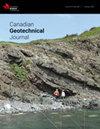用渗透试验控制细粒路堤的质量
IF 3.5
3区 工程技术
Q2 ENGINEERING, GEOLOGICAL
引用次数: 0
摘要
土工压实控制是岩土工程中的一项重要任务。为了建筑的可持续性和降低工程成本,细粒材料现在更多地用于路堤施工。压实土层的质量控制通常根据静态和动态板载试验获得的变形模量或根据压实程度来定义,压实程度通常与普罗克特密度有关。贯入测试,如锥贯入测试(CPT)、地震平面膨胀仪测试(SDMT)或动态探针(DPM),显示了沿垂直剖面评估压实的潜力,但尚未制定标准化的质量标准。本文研究了不同含水量和土壤稳定程度对8 m高粘土-粉质试验路堤CPT、SDMT、DPM、板载试验和Proctor试验结果的影响。发现CPT和DMT结果与静态和动态板载试验的变形模量密切相关,从而能够定义压实控制的新质量标准。本文章由计算机程序翻译,如有差异,请以英文原文为准。
Quality control of fine-grained embankments using penetration tests
The compaction control of earth works is an essential task in geotechnical engineering. In order to build more sustainably and to reduce project costs, fine-grained materials are more often used for embankment construction nowadays. The quality control of compacted soil layers is usually defined in terms of deformation moduli obtained from static and dynamic plate load tests or based on the degree of compaction, which is generally related to the Proctor density. Penetration tests, such as cone penetration tests (CPT), seismic flat dilatometer tests (SDMT) or dynamic probings (DPM), show a potential for assessing the compaction along vertical profiles but no standardized quality criteria have been elaborated yet. The present work investigates the effects of different water contents and degrees of soil stabilization on results of CPT, SDMT, DPM, plate load tests and Proctor tests for an 8 m high trial embankment, characterized by a clayey to silty material. CPT and DMT results were found to strongly correlate with deformation moduli of static and dynamic plate load tests, enabling the definition of new quality criteria for compaction control.
求助全文
通过发布文献求助,成功后即可免费获取论文全文。
去求助
来源期刊

Canadian Geotechnical Journal
地学-地球科学综合
CiteScore
7.20
自引率
5.60%
发文量
163
审稿时长
7.5 months
期刊介绍:
The Canadian Geotechnical Journal features articles, notes, reviews, and discussions related to new developments in geotechnical and geoenvironmental engineering, and applied sciences. The topics of papers written by researchers and engineers/scientists active in industry include soil and rock mechanics, material properties and fundamental behaviour, site characterization, foundations, excavations, tunnels, dams and embankments, slopes, landslides, geological and rock engineering, ground improvement, hydrogeology and contaminant hydrogeology, geochemistry, waste management, geosynthetics, offshore engineering, ice, frozen ground and northern engineering, risk and reliability applications, and physical and numerical modelling.
Contributions that have practical relevance are preferred, including case records. Purely theoretical contributions are not generally published unless they are on a topic of special interest (like unsaturated soil mechanics or cold regions geotechnics) or they have direct practical value.
 求助内容:
求助内容: 应助结果提醒方式:
应助结果提醒方式:


